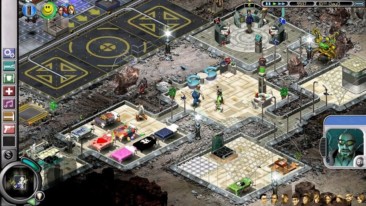Dead Synchronicity: Tomorrow Comes Today – What We Think:
Urged on by an unseen female voice, Michael regains consciousness on a couch in a dilapidated trailer that isn’t his. Other than a feeling of familiarity to the speaker, Michael remembers nothing about the world around him. Rod – the owner of the trailer – tells of an event known as the Great Wave that has shaken civilization to its core. To make matters more dire, a bizarre illness is claiming the lives of millions. No one knows how the illness is spread, and the state of the world is rapidly growing worse.
As payment for taking Michael in and nursing him back to health, Rod bequeaths him to find the rumored cure for the disease before his son Colin succumbs to the “Dissolved” illness and literally melts away. Though he has no knowledge of what awaits in this collapsing world, he must venture out if he is ever to make sense of his predicament.
While the trope of having a player control an amnesiac character in a bizarre new world is a deeply drawn-from well, Dead Synchronicity packs enough style, substance and gorgeous (and often gory) imagery to make piecing Michael’s life back together a chilling and engrossing experience.

Wave Goodbye
Exiting the trailer, Michael discovers a world in which the military has declared martial law and forced displaced individuals into concentration camps, as they have lost control of the spread of the horrible and mysterious wasting disease. Moles are hired from within to keep tabs on new outbreaks in the compounds. Those who have dug in within these ramshackle encampments resort to violence, prostitution and the exchange of black market goods just to get by.
Re-Inventorying the Wheel
The gameplay will be instantly familiar to anyone who has played a standard point and click adventure. By moving the mouse around the screen, points of interest will change the cursor. The points can indicate a useful item, a potential interaction, or just further detail into Michael’s surroundings. Michael can also converse with the handful of people he encounters to deepen his understanding of the new civilization that has emerged from the ashes of the past one.
Scrolling down on the mouse wheel quickly opens the inventory. Selecting an item for use and dragging it out of the confines of Michael’s briefcase will just as rapidly close the inventory screen. On paper, it sounds like a small touch, but it greatly cuts down on the time spent in activities that take away from the action of the game.
Many of the attempts to combine certain items will produce specialized monologues reflecting the attempt. Though there are still the occasional “I don’t see how that will work” type lines, the writers have crafted a veritable heap of script to keep trial-and-error item combinations from becoming needlessly mundane.

The puzzles and solutions are well placed, contextually; they are clever, and with a few exceptions, make enough sense to prevent anyone from getting too hung up on an answer. My only caution would be to make sure to walk into all accessible areas of every screen. There are often items or crucial plot details in places you might not think to look, and should they be off screen, the points of interest indicator (activated by tapping the space bar) will be of little help.
You Ain’t Scene Nothin’ Yet
The desperate overall mood present in the narrative is sharply enhanced by the hand-painted backdrops for each scene, and is peppered by gritty and gruesome action comic interludes. Evidence of blood can be found everywhere, as if it is spilled on a regular basis. Vegetation grows thick in the cracks and crevices of the city, and the desert slowly overtakes the spaces outside what remains of the crumbling metropolis. Though the game will take the player through the handful of screens numerous times, there is enough striking visual detail to ensure that the trip never feels overly dull.

The soundtrack and vocal cast both shine bright against the dingy pallor of the world’s faded glory. Each character is written and acted with great skill and finesse, creating a cast simultaneously worthy of both pathos and revulsion. Though he remembers little of his past, Michael’s inner monologue indicates that he is distinctly aware that the activities around him do not pass the moral sniff test. This said, each new person he meets tells a meaningful tale, preventing the downtrodden and the oppressors alike from coming off as base types.
Time Out
The end of the episode takes a strange turn. While it’s clear that something highly out of the ordinary is taking place, the big M. Night Shyamalan moment lacked the oomph it was so clearly trying to convey. In fact, I had suspected the reveal within the first 10 minutes of the game, and had it all but confirmed when certain moments throughout the game repeatedly hinted at it with all the subtlety of child with motion sickness harnessed to a paint shaker.

Up to this point, the abstract concept was quietly dominated by the gritty survivalist drama. In the closing minutes, the supernatural elements are thrust to the foreground in a prolonged dialogue that basically states (and I spoil nothing that isn’t in the description on the Steam store page) that the flow of time is collapsing in on itself, but we can fix it, because science.
Until Tomorrow
Though a bit abrupt, the end of this episode does set up what appears to be a wildly different second chapter. The first installment is unrelentingly gut-wrenching, and I can only hope that future chapters remain as wickedly blunt. So far, Dead Synchronicity has the narrative and artistic chops to be a great episodic point and click adventure saga.
Dead Synchronicity – Official Site
Get Dead Synchronicity: Tomorrow Comes Today on Steam
Get Dead Synchronicity: Tomorrow Comes Today on GOG
[xrr rating=”4/5″]
Watch the launch trailer for Dead Sychronicity: Tomorrow Comes Today below:





